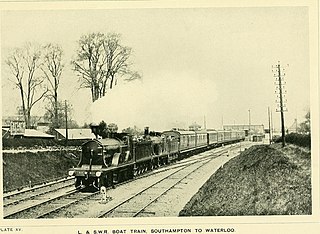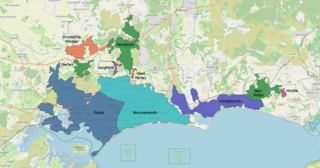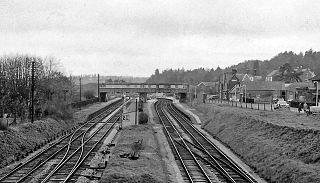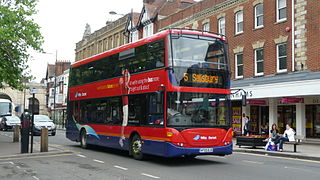
Wimborne Minster is a market town in Dorset in South West England, and the name of the Church of England church in that town. It lies at the confluence of the River Stour and the River Allen, 5 miles (8 km) north of Poole, on the Dorset Heaths, and is part of the South East Dorset conurbation. According to Office for National Statistics data the population of the Wimborne Minster built-up area as of 2014 was 15,552.

The London and South Western Railway was a railway company in England from 1838 to 1922. Originating as the London and Southampton Railway, its network extended to Dorchester and Weymouth, to Salisbury, Exeter and Plymouth, and to Padstow, Ilfracombe and Bude. It developed a network of routes in Hampshire, Surrey and Berkshire, including Portsmouth and Reading.

The Somerset and Dorset Joint Railway, also known as the S&D, SDJR or S&DJR, was an English railway line connecting Bath and Bournemouth, with a branch from Evercreech Junction to Burnham-on-Sea and Bridgwater. Strictly speaking, the main line ran from Bath Junction to Broadstone, as the line between Broadstone and Bournemouth was owned by the London and South Western Railway, while the line between Bath Junction and Bath was owned by the Midland Railway.

The South West Main Line (SWML) is a 143-mile major railway line between Waterloo station in central London and Weymouth on the south coast of England. A predominantly passenger line, it serves many commuter areas including south western suburbs of London and the conurbations based on Southampton and Bournemouth. It runs through the counties of Surrey, Hampshire and Dorset. It forms the core of the network built by the London and South Western Railway, today mostly operated by South Western Railway. Network Rail refers to it as the South West Main Line.

Bournemouth railway station is the main railway station serving the seaside town of Bournemouth, Dorset, England. It was previously known as Bournemouth East and then Bournemouth Central. It has long been treated as an obligatory stop on the South West Main Line from London Waterloo to Weymouth. It is 108 miles 2 chains (173.8 km) down the main line from Waterloo and is situated between Pokesdown and Branksome.

Brockenhurst railway station serves the village of Brockenhurst in Hampshire, England. It is located on the South West Main Line from London Waterloo to Weymouth. It is also the junction of the Lymington Branch Line with the main line. It is 92 miles 66 chains (149.4 km) down the line from Waterloo. It is managed and served by South Western Railway and it is also served by CrossCountry trains.

The South East Dorset conurbation is a multi-centred conurbation on the south coast of Dorset in England.

Poole railway station is on the South West Main Line serving the town of Poole in Dorset, England. It is situated in the town centre next to Holes Bay. It is one of four stations in the Borough of Poole and is 113 miles 62 chains (183.1 km) down the main line from London Waterloo.

Ringwood is a closed railway station in the county of Hampshire, England which served the town of Ringwood. It lay on the former Southampton and Dorchester Railway, the original main line from a connection with the London and South Western Railway at Southampton through Brockenhurst to Dorchester.
The Wilts, Somerset and Weymouth Railway (WS&WR) was an early railway company in south-western England. It obtained Parliamentary powers in 1845 to build a railway from near Chippenham in Wiltshire, southward to Salisbury and Weymouth in Dorset. It opened the first part of the network but found it impossible to raise further money and sold its line to the Great Western Railway (GWR) in 1850.

Dorset is a county in South West England. The county is largely rural and therefore does not have a dense transport network, and is one of the few English counties without a motorway. Owing to its position on the English Channel coast, and its natural sheltered harbours, it has a maritime history, though lack of inland transport routes have led to the decline of its ports.

Verwood railway station served the town of Verwood, Dorset, and its hinterland, from 1866 to 1964. It was one of many casualties of the mass closure of British railway lines in the 1960s; the last train running on 2 May 1964. The village is now much larger than when the line ran as it is within reasonable travelling distance of the South East Dorset conurbation.
The Salisbury and Dorset Junction Railway was a railway company, that built a line from a junction near Salisbury to another near West Moors on the Ringwood to Wimborne line. It ran through the counties of Wiltshire, Hampshire and Dorset in England. It opened the line in 1866, and was worked by the London and South Western Railway (LSWR).

The Southampton and Dorchester Railway was an English railway company formed to join Southampton in Hampshire with Dorchester in Dorset, with hopes of forming part of a route from London to Exeter. It received Parliamentary authority in 1845 and opened in 1847.

Broadstone was a railway station in the northern part of the Borough of Poole in the county of Dorset in England. It opened in 1872 under the name of New Poole Junction and closed to passengers in 1966. Between these dates there were several changes of name for a station which at its height provided a suburb of Poole with four substantial platforms and a goods yard. A prominent feature of the station was the large footbridge needed to span the four running lines.
This article describes the history and operation of the railway routes west of Salisbury built by the London and South Western Railway (LSWR) and allied companies, which ultimately became part of the Southern Railway in the United Kingdom. Salisbury forms a natural boundary between the Southern Railway core routes in the counties surrounding London, and the long route connecting with the Devon and Cornwall lines.
The Ringwood, Christchurch and Bournemouth Railway was a railway company to link Christchurch and Bournemouth, England, to the London and South Western Railway's Southampton and Dorchester line at Ringwood. The RC&BR opened in 1862 from Christchurch to Ringwood, and was extended to Bournemouth in 1870, sharing in the growing popularity of the town. However the route was circuitous, and the London and South Western Railway opened a shorter route between Brockenhurst and Christchurch via Sway in 1888, making the Ringwood to Christchurch section a branch line.

Wilts & Dorset is a bus and coach operator providing services in East Dorset, South Wiltshire, and West Hampshire. It operates services under the morebus brand around Bournemouth and Poole, and under the Salisbury Reds brand around Salisbury and Amesbury. It is part of Go South Coast, a subsidiary of the Go-Ahead Group.
The Salisbury and Yeovil Railway linked Salisbury (Wiltshire), Gillingham (Dorset) and Yeovil (Somerset) in England. Opened in stages in 1859 and 1860, it formed a bridge route between the main London and South Western Railway (LSWR) network and its lines in Devon and Cornwall. Its trains were operated by the LSWR and it was sold to that company in 1878. Apart from a short section in Yeovil it remains open and carries the London Waterloo to Exeter service of South Western Railway.















